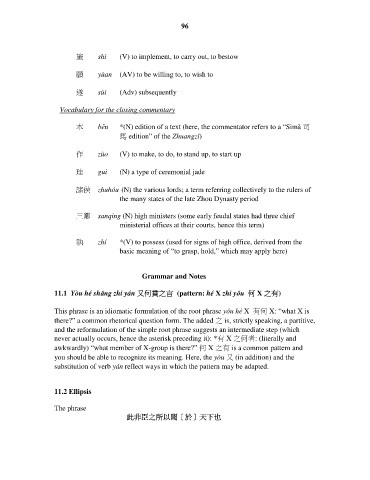Page 104 - EALC C306/505
P. 104
96
施 shi (V) to implement, to carry out, to bestow
願 yùan (AV) to be willing to, to wish to
遂 sùi (Adv) subsequently
Vocabulary for the closing commentary
本 bĕn *(N) edition of a text (here, the commentator refers to a “Simă 司
馬 edition” of the Zhuangzǐ)
作 zùo (V) to make, to do, to stand up, to start up
珪 gui (N) a type of ceremonial jade
諸侯 zhuhóu (N) the various lords; a term referring collectively to the rulers of
the many states of the late Zhou Dynasty period
三卿 sanqing (N) high ministers (some early feudal states had three chief
ministerial offices at their courts, hence this term)
執 zhí *(V) to possess (used for signs of high office, derived from the
basic meaning of “to grasp, hold,” which may apply here)
Grammar and Notes
11.1 Yòu hé shăng zhi yán 又何賞之言 (pattern: hé X zhi yǒu 何 X 之有)
This phrase is an idiomatic formulation of the root phrase yǒu hé X 有何 X: “what X is
there?” a common rhetorical question form. The added 之 is, strictly speaking, a partitive,
and the reformulation of the simple root phrase suggests an intermediate step (which
never actually occurs, hence the asterisk preceding it): *有 X 之何者: (literally and
awkwardly) “what member of X-group is there?” 何 X 之有 is a common pattern and
you should be able to recognize its meaning. Here, the yòu 又 (in addition) and the
substitution of verb yán reflect ways in which the pattern may be adapted.
11.2 Ellipsis
The phrase
此非臣之所以聞[於]天下也

